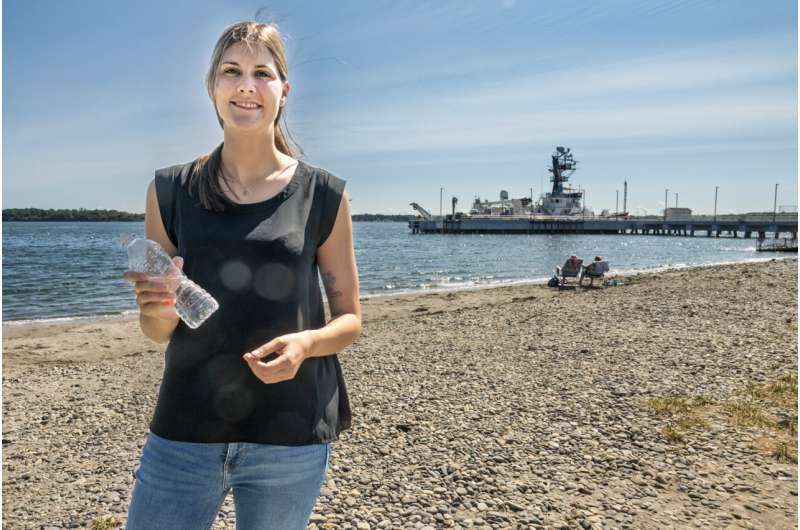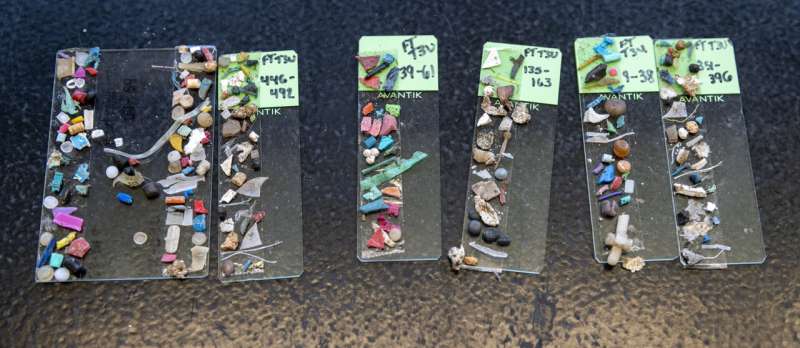This article has been reviewed according to Science X's editorial process and policies. Editors have highlighted the following attributes while ensuring the content's credibility:
fact-checked
peer-reviewed publication
trusted source
proofread
New study finds extensive microplastics in Narragansett Bay

Two University of Rhode Island researchers estimate that the top 5 centimeters (2 inches) of the floor of Narragansett Bay now contain more than 1,000 tons of microplastics, and that buildup has occurred in just the last 10 to 20 years.
This news is likely to stun generations of Rhode Islanders who have gotten their first taste of ocean life at the shoreline. From Oakland Beach to Salty Brine Beach, a Rhode Island child's introduction to the ocean often happens first at the water's edge, with a pail and a shovel, digging at the tide line.
URI researchers were surprised by the amount of microplastic storage taking place in Narragansett Bay.
It's a pretty picture, but what are they digging up?
A new study published by the University of Rhode Island's Graduate School of Oceanography is giving state residents, and the future generation of beachgoers, a clearer picture of what exactly is being found in Narragansett Bay.
Littering of single-use plastic items is one source of microplastic pollution. Most microplastics are eventually deposited on shorelines and in marine sediment.
Doctoral student Victoria Fulfer and J.P. Walsh, director of URI's Coastal Resources Center, recently published a study analyzing the percentage of microplastics in Narragansett Bay. Their study represents the first such study of the bay, offering a baseline look at impact on Narragansett Bay. Fulfer and Walsh say that the level of plastics being stored in the Bay is dramatic and startling. They recently published their results in Scientific Reports.
Both say they were surprised by the sheer amount of microplastics in the bay.
"The amount there is really shocking," Fulfer says.

Research journey
In her lab at URI's Narragansett Bay Campus, Fulfer examines microplastics, small plastic particles 5 millimeters or smaller. The smallest of these can't be seen without a powerful microscope; the largest are plastic production pellets called "nurdles." About the size of a pea or piece of couscous, they look a little like Dippin' Dots. We might be consuming them, too, but they're nowhere near as tasty or fun.
As a new student at URI, Fulfer pictured herself drawing blood someday, not water samples. She had her sights set on medical school after college. A summer job at the Graduate School of Oceanography let her experience ocean research, performing DNA extraction of bacteria living in the seafloor to hone her molecular skills for medical school. In her senior year at URI, she got the chance to go out on the research vessel Endeavor. Though she thought it a "cool opportunity," Fulfer headed to medical school at the University of Massachusetts after graduation, as planned. It was there that she realized her true calling—and found her way back to the Bay Campus.
"I missed the culture of ocean science and being in the field," she says, and decided to return to URI for her master's of science in oceanography.
Now her study with Walsh presents the first assessment of microplastic storage in Narragansett Bay, and indicates that plastic storage is extensive in the bay, especially in its upper parts near Providence.
Microplastic pollution comes from runoff, littering of single-use plastic items, wastewater treatment facilities, shipping, industrial plastic production, and fisheries. However, it's estimated that only 1% of that marine plastic remains in the water column. Most microplastics are eventually deposited on shorelines and in marine sediment, an unpleasant and likely harmful souvenir of some beachgoers.
With more than 16 trillion microplastic particles trapped in the top layer of Narragansett Bay's sediment, the bay is in essence serving as a filter for plastic pollution. This trapping has negative consequences, and may cause behavioral changes in mammals, but might also point the way to potential for efficient removal. Coastal habitats are more easily accessible than the open ocean, making clean-up efforts more feasible.
This first system-wide study of estuarine sediments also provides evidence that coasts bear the burden of high microplastic contamination. These observations raise concern about ecosystem consequences, but also offer an opportunity for more efficient plastic removal to help limit impact on the ocean.
Of course, measuring the microplastics can only go so far: at a certain size, plastics are too small to capture and measure, though that doesn't mean they can't get into your body or the food on your plate.
Narragansett Bay: Toxic catch basin or a cleaner future?
Development in and around Providence starting with the Industrial Revolution led to the bay making news for its pollution in the 1970s when organizations like Save the Bay started calling attention to the need to protect Rhode Island's largest natural resource.
With more than 700 billion gallons of water across 150 square miles, the bay's unique configuration means that if the water can be cleaned up, it will likely stay clean and healthy.
Reducing plastic inputs will help.
At the source
Microplastics in Narragansett Bay come from single-use plastics in most cases, from bags, bottles and packaging. That plastic bag floating down your street can make its way to the bay and become microplastic debris that you eventually swim past. There's not a lot of intentional dumping in Rhode Island, but plastics are still getting into the bay.
Looking at personal plastic use is a great place to start to remedy the problem, Fulfer says. While her research at GSO is putting her right at the forefront of research in this growing field, she's become more mindful along the way about her own plastic choices outside of the lab, from shampoo bottles to using a bamboo toothbrush.
Another way to help is adding "refuse" to your environmental vocabulary, following the mantra of "refuse reduce reuse recycle." Avoid taking the restaurant container if you don't need it. Fulfer says that picking up litter and keeping plastics out of the natural environment helps. "Any small action is helpful," she says. "It makes a difference."
She often staffs the booth at GSO events and enjoys talking to children and adults interested in the issue. "The kids have good ideas and creative solutions," she says. "We need them."
Waste matters
Fulfer says that the orientation of the Bay and Rhode Island's small size means there is a good chance of success in righting the ship, if addressed.
"If we could champion this, we would see a real reduction," she says.
Things like the plastic bag ban in Rhode Island is a start.
"It's not just about the bay looking good for a picture, it's about what the science says about the health of the ecosystem and potential impacts on our communities," Fulfer says. While noting that habit-changing takes adjustment, she says that people in Rhode Island, and legislators, are receptive. "Tourism and fishing are part of our economy. People get it here."
Microplastics are still a new area of study and right now, California is the only state monitoring microplastics. Rhode Island's research at URI, with the support and interest of the state Department of Environmental Management, could be the start of oversight here.
Fulfer and Walsh hope that the Ocean State can live up to its name and become a leader on the East Coast.
"If we could really be at the forefront of minimizing plastic use," Fulfer says, "we could be the first state on the East Coast to make actionable change for the bay and our entire coastal system."
More information: Victoria M. Fulfer et al, Extensive estuarine sedimentary storage of plastics from city to sea: Narragansett Bay, Rhode Island, USA, Scientific Reports (2023). DOI: 10.1038/s41598-023-36228-8
Journal information: Scientific Reports
Provided by University of Rhode Island





















